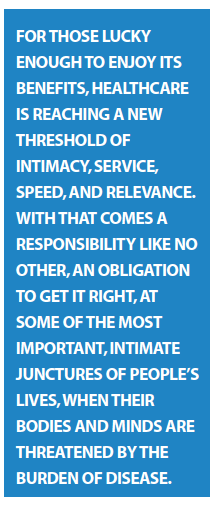 “The world would be a better place…" It’s a short phrase that can provoke powerful thought experiments… and can even transform the way we live.
“The world would be a better place…" It’s a short phrase that can provoke powerful thought experiments… and can even transform the way we live.
At Ogilvy, and Ogilvy CommonHealth Worldwide, we start all of our discussions with this simple framework. The world would be a better place, if… And when the topic is patient-centricity, it’s natural to start thinking about how the world could be a better place — not for “patients," but for each and every person who is living with a chronic condition, an ailment of mind or body that affects their daily lives, from work, family and relationships, to their very sense of identity and purpose.
If we all sat together in a workshop, we would come up with a thousand creative ways to describe how to continue the job of better understanding and serving people’s individual healthcare needs. But here, today, let’s just start with a few — and we hope it will lead you to your own ideas as well.
Serving Patient Needs
The world would be a better place if…
… we knew our bodies well enough to make informed decisions for long-term health
… our doctors and healthcare providers could communicate across specialties and geographies to become our personal Board of Directors for our healthcare
… the companies that manufacture the prescriptions and OTC remedies and devices could customize everything they do to meet our individual needs
… all of us could live the healthiest, fullest lives possible.
So let’s imagine a world where…
We’ve digitized our DNA, making it possible for our doctors to prescribe remedies that work with our particular biological fingerprint. It’s not science fiction: MIT reported recently that Apple, Google, and the U.S. government, among others, are all advancing that frontier, called the Internet of DNA. What could be more patient-centric than when we, and the people tasked with caring for our mental and physical health, can peer inside the black box of our bodies and decode the direction we need to take our behaviors?
An example: A friend learned from his genomic scan that his body naturally overproduces iron. Result? New behaviors, including choosing a diet less reliant on meat, and the addition of magnesium to neutralize the abundance of iron. In Hong Kong, researchers are following a thousand people with hepatitis B to see if a DNA blood test can spot liver tumors before an ultrasound can. A survey posted on Genome Web suggests that the scientific community is optimistic: about 60% think we’ll be sharing our DNA on a widespread basis by 2020. Knowing our genomic codes will give us freedom to make even more nuanced choices about what we do, when we seek care, and the best possible solutions for our well-being.
 And from there it’s a very short leap to imagine a world in which pharma, with blinded access to the Internet of DNA, uses 3D printing technology to create individualized therapies for everything from MS and Parkinson’s to lipid-lowering statins to…well, you name it.
And from there it’s a very short leap to imagine a world in which pharma, with blinded access to the Internet of DNA, uses 3D printing technology to create individualized therapies for everything from MS and Parkinson’s to lipid-lowering statins to…well, you name it.
Imagine a day not too far from now, when individual pills, injections, and infusions are customized to your DNA. And as you may know, the FDA has already approved the very first 3D-printed pill that allows each person to receive his or her own individualized dose. It’s not yet customized to DNA, but it’s not hard to see the day when we each have a personal portfolio of medications or print them out on demand on our own home 3D printers.
We’ll move beyond words to images, which are said to comprise up to 90% of all medical data, but are notoriously hard to search and analyze. That said, you probably already know that IBM is programming Watson to use medical imagery to identify tumors, melanomas, heart disease and more. Our doctors will be able to diagnose us more quickly and accurately, and devise treatment regimens that have more hope of healing.
With the influx of data, imagine a world where the healthcare industry transforms into a service industry, in which patient health metrics drive company decisions. The ability to measure a host of outcomes allows us to focus on new KPIs, for instance, identifying mood swings among people with bipolar disorder, simply by measuring how their voice sounds on the phone. Or tracking improved lung health for asthma patients who use a “smart inhaler" that tells them whether they’re inhaling the right amount of medicine. Or maintaining foot health among people with diabetes, using sensor-laden smart socks.
Accenture calls these and the many, many other patient-centric technologies being developed “the third wave" of transformative digital services. And they’ve identified the healthcare industry as the definitive leader in pioneering a new level of service for the people who need our help.
Universal Patient Identifiers
The next big question, of course, is where does all the data generated by these technologies live? And how do we not just harness it, but access it—and use it to our benefit? Someday, along with a social security number, phone number, and email address, futurists predict that we may have a universal patient identifier: a personal code that allows us to give any provider access to our medical records, stored securely in the cloud, beyond the confines of EHR systems that don’t seamlessly share or port data.
Our medical records will follow us from birth: every vaccination, every bout of childhood disease, every surgery, every CT-scan, every prescription. Infants born today can have their biodata tracked by wearables like Mimo — and just like their older siblings’ embarrassing Instagrams, that data can follow them forever. Matching our lifetime medical records with our DNA fingerprint, our wearables and implantables, and data about environmental hazards particular to our diets, jobs, or regions, will allow our doctors to provide proactive care, sending us to leading experts in the specialties most relevant to us.
Crowdsourcing Platform
Beyond that may lie a crowdsourcing platform, a place where your doctors, devices and diagnostic tests come together to become a personal advisory board, adapting with us as we age. In this future state, we could have on-call access to providers anywhere in the world. We could track our moods, symptoms, habits and triggers — and purchase products and services that meet our needs at any moment, all rated by our peers. 3D printer filaments will become as much a part of our first-aid kits as bandages. Is an Amazon Health platform so far away? Well, no: they’re working on it.
Brand Personalization
And yet. For years, it’s been the dream of marketers to push the boundaries of mass customization, to create bespoke solutions for each customer, tailor-made to their needs and wishes. And in many areas, that dream has come to life: simple, individual data inputs let us order anything from made-to-measure shirts from Proper Cloth, customized boxes of ingredients (and chef’s recipes) from Plated, a personalized can of Coke, even your own custom car. As consumers, we’re learning to expect personalized products and recommendations from the brands we choose; we’re open to sharing our information with both friends and strangers.
Healthcare, though, is so much more complicated than ordering a shirt with a custom-fit collar, or sharing vacation pictures on Facebook. Each of us has different physical and emotional needs, comorbidities, allergies, abilities, and levels of how well we understand and process complicated medical terminology. Each of us lives with varying levels of comfort as to how much of our healthcare information is shared — and with whom. Healthcare privacy is a common concern, and with it, a fear that our most intimate data might be used in some way that’s not in our best interests.
Sharing the Job
Opportunities for pharma to advance the field are enormous, but they’re not limited to new apps and devices. Some of the greatest advances may lie in moving beyond our own corporate boundaries, our cultural comfort zones, our competitive natures. We may need to stop thinking about “owning" the patient, and start thinking about “sharing" the job of advancing her health and protecting her privacy.
Perhaps we’ll be moved to work together on some of the next wave of technological advances, pairing our innovations with a vision for meeting shared human needs. Here are just three thought-starters:
How can we contribute to the growth of secure platforms for telehealth, eliminating the barrier of a physical HCP visit for people too sick, or too far away from their doctors, to travel?
How can we collaborate with our competitors to create a universal database of patients — a national healthcare registry that would not only serve individuals, but also advance epidemiology and pubic health research?
How can we ensure that people meet their healthcare needs with less stress, worry, and anxiety — offering credible information in words and languages they understand, with easy access to action-oriented resources—including human beings who can provide physical, social or spiritual care?
We can let Apple, Google, IBM and Amazon take the reins, or we can consider using the power of our industry to work together toward a shared future.
Because technology, as every article in this magazine will attest, is only moving forward, in every possible direction. Check out Professor Julia Greer at CalTech, whose work in nano-architecture is reimagining what surgeons can do in structures as delicate as the inner ear. Look at Japan, where robots are being tested in nursing roles. Smart cars will take us to our medical appointments — no driving required, a particular boon for those with limited vision, cognitive impairment, or movement disorders. By 2025, just 10 years from now, analysts believe we may be treating a wide variety of cancers without toxic side effects, decoding — and modifying —genomic mutations to prevent dementia.
The Intersection of Innovation and Human Needs
For those lucky enough to enjoy its benefits, healthcare is reaching a new threshold of intimacy, service, speed, and relevance. With that comes a responsibility like no other, an obligation to get it right, at some of the most important, intimate junctures of people’s lives, when their bodies and minds are threatened by the burden of disease.
Meeting that responsibility lies in an intriguing combination of head and heart, where technical innovation and brilliant applications of data meet pure human needs and the swirling emotions of our most vulnerable moments.
So what will make the world a better place? It’s already happening. You’re already doing it.
Just imagine this better world, and keep working to create it.
Ogilvy CommonHealth Worldwide — the health behavior specialists of Ogilvy & Mather — is committed to creativity and effectiveness in healthcare communications, everywhere.
For more information, visit ochww.com.


















